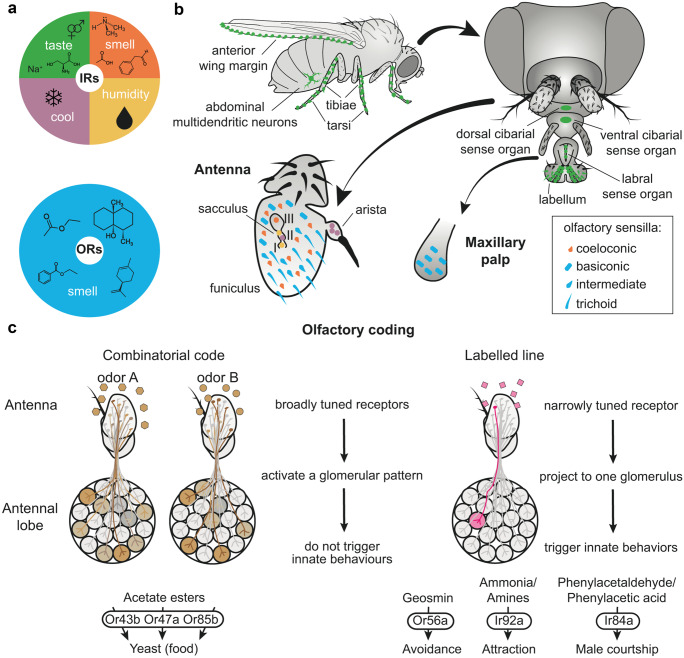Fig. 1.
Functional roles and coding strategies of insect IRs and ORs. a Sensory modalities of ionotropic receptors (IRs) and odorant receptors (ORs). IRs are a multi-modal gene family for the detection of multiple taste qualities, volatile acids and amines, and environmental stimuli as humidity and cooling temperatures (Rimal and Lee 2018). ORs instead are specialized for the detection of a wide variety of volatile and semi-volatile compounds. b Distribution pattern of IRs and ORs in the adult vinegar fly Drosophila melanogaster. Candidate IR taste and pheromone receptors are expressed in the anterior margin of the wing, on abdominal multidendritic neurons, on the tibiae and tarsi of the legs, and on the labellar, labral and cibarial sense organs (Koh et al. 2014; Sánchez-Alcañiz et al. 2018). The antennal funiculus and the maxillary palps are the two main olfactory organs and they are covered with porous sensilla. The coeloconic sensilla house olfactory neurons expressing mainly IRs, while the basiconic, intermediate, and trichoid sensilla house OR-expressing neurons. The antenna houses two other sensory structures, namely, the sacculus and the arista, that express IRs involved in humidity and cooling sensing (Frank et al. 2017; Knecht et al. 2017). c IRs and ORs allow insects to detect a wide range of ecologically relevant chemicals through a combinatorial code and a set of labeled lines. In a combinatorial code, each odor is detected by multiple broadly tuned receptors and elicits a unique activation pattern of the antennal lobe glomeruli. Such mechanism allows the fly to exploit a wide array of food sources through the detection of multiple acetate esters produced by yeasts (Mansourian and Stensmyr 2015). Odors detected through labeled lines activate only one tuning receptor and trigger specific innate behaviors (Grosjean et al. 2011; Min et al. 2013; Stensmyr et al. 2012)

